Leash Kitesurfing: Techniques, Safety, and Advancements


Intro
Kitesurfing has gained popularity among adventure seekers and extreme sports enthusiasts. Among the various techniques, leash kitesurfing stands out as a critical aspect of ensuring both safety and performance. This practice requires a solid understanding of equipment, specific practices, and various techniques. The importance of a leash cannot be overstated, as it connects the kite to the rider. This connection is vital in enhancing control and minimizing risks. With a range of advances in gear and safety measures, it's crucial for both beginners and experienced surfers to stay informed.
This article explores the multidimensional aspects of leash kitesurfing, offering insights that can help riders elevate their skills while prioritizing their safety. From understanding practical techniques to acknowledging important safety gear, readers can expect comprehensive information that illuminates the complexities of this thrilling sport.
Preamble to Kitesurfing
Kitesurfing combines elements of surfing, paragliding, and windsurfing into one thrilling water sport. Its significance lies in its ability to offer a unique experience that blends the power of the wind with the skillful maneuvering of a kite. Understanding kitesurfing is essential for anyone interested in exploring leash kitesurfing, as it provides a foundation for recognizing how techniques and safety standards can enhance performance and enjoyment.
Historical Background
The origins of kitesurfing can be traced back to the early 1980s when pioneers began experimenting with the use of kites to propel surfboards on water. The sport gained momentum in the 1990s, marked by the development of specialized kites and gear. Notably, the introduction of the inflatable kite revolutionized the pursuit, providing better control and stability. As kitesurfing grew in popularity, various riding disciplines emerged, including freestyle and wave riding, each offering distinct challenges and rewards.
Evolution of Equipment
The evolution of kitesurfing equipment has been pivotal in the sport’s advancement. Early models relied heavily on innovation but lacked safety features; thus, the evolution sought to improve user experience. Modern kitesurfing gear now includes various elements designed specifically for performance and safety.
- Kites: Today’s kites are designed with advanced materials, allowing them to be lighter and more durable. They come in different sizes and shapes tailored for specific wind conditions, enhancing versatility.
- Boards: The connection between the board and the rider is crucial. Modern boards come with various shapes, sizes and designs, providing options for different styles of riding.
- Leashes: One of the most important advancements is the design of leashes. Different types of leashes like the quick-release have contributed enormously to safety by enabling riders to detach quickly from their kites during emergencies.
As a result of these advancements, kitesurfing has become more accessible, attracting a diverse range of enthusiasts, from beginners to seasoned thrill-seekers.
Understanding the Leash
The leash is a critical component of kitesurfing, serving as a direct line between the rider and the kite. Its purpose stretches beyond keeping the kite tethered; it plays a vital role in safety and performance. Understanding how the leash functions is essential for anyone involved in the sport. Knowing the different types of leashes, their specific benefits, and their drawbacks helps kitesurfers make informed decisions about their equipment. This understanding can affect not only the enjoyment of the sport but also the level of safety during extreme maneuvers on the water.
Purpose of the Leash
A leash is designed to prevent the kite from drifting away when the rider falls or loses control. This aspect is crucial, especially in strong winds where a runaway kite can pose significant risks to others and the rider themselves. Moreover, the leash allows for better control of the kite during transitions or tricks. The connection enables the rider to manage the kite's position more effectively, enhancing overall performance.
Types of Leashes
Kitesurfing offers various leashes tailored to different styles and focuses on safety priorities. Below are the key types of leashes frequently used by kitesurfers:
Standard Leash
The standard leash is the most basic type, designed simply to connect the rider to the kite. It typically offers a straightforward approach to kitesurfing. Its main characteristic is durability, as it often features robust materials resistant to wear and tear. This reliability makes the standard leash a popular choice among beginners who are just learning the ropes.
One unique feature of the standard leash is its non-releasing mechanism, meaning it remains attached unless manually detached. This reliability can be advantageous in expected riding conditions, but it can also lead to potential hazards if the rider is unable to disconnect quickly in emergencies.
Quick-release Leash
The quick-release leash significantly enhances safety by allowing a rider to detach from the kite swiftly. This leash is built with a mechanism that enables a quick pull, instantly severing the connection. The primary characteristic of this type of leash is its emphasis on instantaneous control and rider safety.
One unique feature is that it can be released even while being dragged through the water, allowing for a rapid exit from a dangerous situation. While this is beneficial, it requires practice to ensure a smooth operation during high-pressure scenarios.
Safety Leash
Safety leashes are specifically designed with safety as the top priority. They often come equipped with features like automatic release mechanisms or additional hooks to further reduce the risk of accidents. The key characteristic of a safety leash is its ability to quickly deactivate the connection without requiring extensive movement from the rider.
A unique feature of safety leashes is their multiple attachment points, enabling easy transitions and the ability to connect in various configurations to maintain control. However, one disadvantage might be the complexity of setup for beginners, as it may take time to learn their full functionality.
Understanding these leash types helps kitesurfers appreciate the importance of safety and performance in the sport. By choosing the right leash, riders empower themselves to take full advantage of kitesurfing's thrilling experience.
Techniques of Leash Kitesurfing
The topic of techniques in leash kitesurfing is crucial for any kitesurfer, from beginners to experts. Understanding these techniques can significantly impact performance and enjoyment of the sport. Mastering the art of leash kitesurfing creates a more dynamic experience on the water. It allows for greater control and safety, reducing the risks associated with kitesurfing.
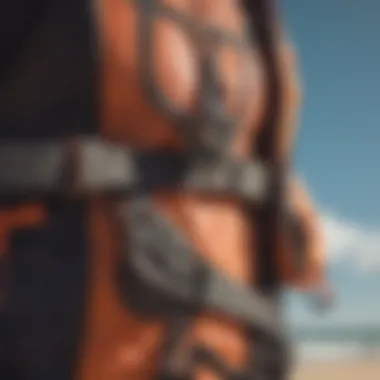
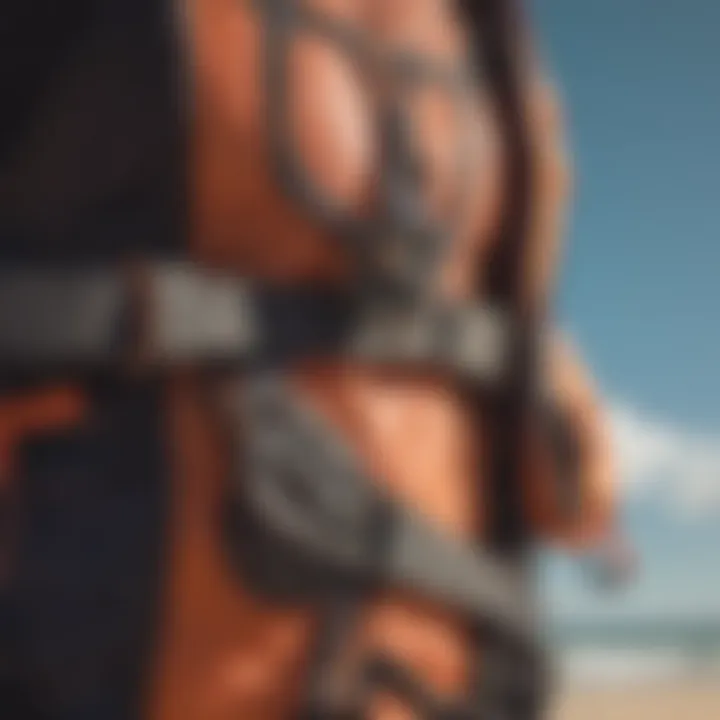
Learning the proper techniques can lead to improved maneuverability and skillful navigation in various conditions. This section will explore both basic techniques and advanced maneuvers that extend the kitesurfer's abilities while out on the water.
Basic Techniques
Basic techniques are foundational for every kitesurfer. They include essential skills that all participants must grasp. These techniques ensure safety and provide a platform to build more complex skills.
Some of the critical basic techniques include:
- Launching and Landing: Correctly launching and landing the kite is crucial. This step involves coordinating with ground assistants, maintaining control, and understanding the wind conditions.
- Body Dragging: Before getting on the board, body dragging is an essential skill. It teaches kitesurfers how to control their kite while in the water without the board.
- Water Start: Transitioning from body dragging to standing on the board is vital. The water start technique helps beginners become comfortable with getting up on their feet with the kite power.
Learning these skills is valuable for safety and enhances confidence on the water. Mastery of the basics allows for a smoother transition to more complicated maneuvers.
Advanced Maneuvers
Once the basics are established, kitesurfers can begin to explore advanced maneuvers. These techniques provide an opportunity to express creativity and individual style while riding. Advanced maneuvers require a keen understanding of wind dynamics and kite control.
Some advanced maneuvers include:
- Jumping: This maneuver involves a combination of kite control and board skills. Learning to jump opens up a new realm of possibilities for tricks and stunts.
- Waves Riding: This technique requires a deep understanding of the surf's flow and how to adapt one’s board and kite positioning. Mastering waves riding can bring a thrilling level to kitesurfing.
- Tricks and Spins: Advanced tricks, such as 360 spins or grabs, demand skill and timing. They showcase a high level of ability in controlling the kite while executing complex movements.
Achieving proficiency in these advanced techniques will undoubtedly enrich the kitesurfing experience. Kitesurfers can connect with the sport on a deeper level, pushing their limits and exploring their capabilities in various conditions.
"Techniques are not just skills; they are the art of kitesurfing. Mastery leads to freedom on the water."
Safety Considerations
Understanding safety considerations in leash kitesurfing is crucial for ensuring a rewarding experience in this adrenaline-fueled sport. Safety measures not only protect the individual kitesurfer but also enhance the overall kitesurfing community's awareness regarding best practices. As the sport continues to evolve, being conscious of safety requirements will significantly minimize risks, keeping kitesurfing an enjoyable activity.
Importance of Safety Gear
Safety gear plays a pivotal role in protecting kitesurfers from potential injuries. Key pieces of equipment include:
- Life jackets: These provide flotation and are crucial in case of falls into deep water.
- Helmets: Helmets protect against head injuries caused by falls or collisions with equipment.
- Impact vests: These offer additional cushioning for the body, reducing the risk of injury during high-impact scenarios.
Each item serves its purpose, ensuring that kitesurfers can venture into unpredictable conditions without exposing themselves to undue harm. With well-fitted gear, the chances of accidents diminish significantly, thus enabling kitesurfers to concentrate on mastering techniques without being overly concerned about their safety.
"Safety gear is not just an accessory; it is a lifeline in critical situations."
Common Risks and Hazards
Engaging in leash kitesurfing, like any water sport, entails certain risks. Some of the more common hazards include:
- Collisions with obstacles: Both natural (like rocks, reefs) and man-made (such as boats, piers) barriers present risks.
- Strong wind conditions: Sudden gusts can lead to loss of control and accidents.
- Tangled lines: Issues may arise from improperly stowed lines, causing entanglement in the kite or around the kitesurfer.
Kitesurfers must remain vigilant and aware of their surroundings at all times. Moreover, choosing to practice in familiar geographical locations and during appropriate weather conditions can dramatically lessen risks. Understanding these elements helps create a foundation of safety, fostering a more conducive environment for learning and enjoyment in the sport.
Ultimately, prioritizing safety is essential for kitesurfers of all levels. By investing in quality safety gear and acknowledging potential hazards, enthusiasts can focus more on improving their skills and less on worrying about injuries.
Choosing the Right Gear
Choosing the right gear for leash kitesurfing is critical for enhancing performance and safety. Appropriate equipment can significantly influence the experience on the water and help riders achieve their potential. The right kite and board combination allows for better control, speed, and maneuverability. Additionally, proper gear reduces the risk of accidents. It is essential to consider various factors when selecting kitesurfing equipment. Riders should evaluate their ability levels, local conditions, and personal preferences to ensure an optimal kitesurfing encounter.
Selecting a Kite
Selecting a kite involves understanding different sizes and shapes to match your skill level and the wind conditions. Kites vary in size, which directly affects their power and control. A smaller kite is easier to handle but may not provide sufficient power in lighter winds. Conversely, a larger kite generates more power and is beneficial in strong winds. Here are some key elements to consider when choosing a kite:
- Size: The kite should be proportionate to your weight and the wind conditions. Beginners might start with a medium-size kite that offers versatility for various weather.
- Aspect Ratio: This term refers to the relationship between the kite's height and width. Higher aspect ratio kites are faster and more efficient for advanced maneuvers, while lower ratios offer stability for beginners.
- Material Quality: Durable and lightweight materials improve kite performance. High-quality kites withstand wear and tear better, ensuring longevity and safety.
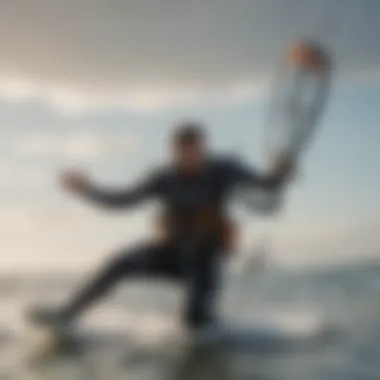

Overall, ensure the kite aligns with your goals and comfort on the water.
Finding the Right Board
Finding the right board is equally essential in leash kitesurfing. Boards come in different shapes and constructions, affecting performance and rider experience. The choice of boards can either enhance or hinder your kitesurfing performance. Here are some factors to weigh when selecting a board:
- Board Type: There are primarily two board types: twin tips and directional. Twin tips are suitable for riding both ways, offering versatility for tricks. Directional boards are better for surfers looking to ride with a surf-style approach.
- Size and Shape: A longer board provides better stability and upwind performance, while a shorter board allows for easier maneuverability. Choose a shape that complements your riding style.
- Flex and Material: The board's flex affects its performance. A stiffer board offers better control at high speeds, while a softer flex provides more comfort on rough waters.
"The right board can transform your kitesurfing experience, making it more enjoyable and efficient."
Assessing your skills and preferences alongside these factors will lead to a well-informed decision. A suitable board enhances navigation through water and wind variations, which is vital in leash kitesurfing.
Weather and Water Conditions
Weather and water conditions play a crucial role in leash kitesurfing. Understanding the environment is essential for both safety and performance. Factors such as wind speed, direction and water state can directly affect the kitesurfer's experience. Each of these elements contributes to both the challenge and enjoyment of the sport.
Good weather conditions can enhance the kitesurfing experience, allowing riders to enjoy their time in the water while performing tricks with confidence. Conversely, adverse conditions may lead to dangerous situations or even accidents. Thus, paying attention to these factors is vital before embarking on a kitesurfing session.
Understanding Wind Patterns
Wind patterns are perhaps the most important aspect of kitesurfing. The behavior of wind can range from gentle breezes to strong gusts, affecting the kite's performance. Riders must learn to read the wind effectively. This skill can make the difference between a thrilling ride and a hazardous experience.
- Wind speed is measured in knots, and each kitesurfing kite has a designated wind range.
- Understanding how to interpret wind direction is as important. For instance, onshore winds can help beginners, while offshore winds can be treacherous.
By familiarizing with local wind tendencies, one can better predict how the kite will behave under varying conditions. It is good practice to monitor update forecasts regularly. Good kitesurfers not only rely on the reported data but also observe their surroundings, such as flags and trees.
Assessing Water Conditions
Water conditions are equally important to consider while kitesurfing. The state of the water can vary significantly, from smooth to choppy. Waves can pose additional challenges or can be used to perform jumps and tricks. Assessing the water involves evaluating several key aspects:
- Water depth: Shallow areas can be risky if a fall occurs.
- Current strength: Strong currents can affect how easily a rider can maneuver.
- Wave size and frequency: High waves can throw off balance.
An awareness of these factors allows riders to adapt their techniques accordingly. It also informs their choice of equipment based on the specific conditions.
It's essential to remember that both wind and water dynamics can change quickly. Therefore, being prepared and adaptable is what differentiates experienced kitesurfers from novices.
Training and Skill Development
Training and skill development are fundamental aspects of leash kitesurfing. They play a crucial role in enhancing one's performance and safety on the water. Whether you are a beginner or an experienced kitesurfer, ongoing training is necessary to stay updated with techniques and safety protocols. Proper training helps avoid accidents and builds confidence in handling kites and boards in various conditions.
Professional Training Schools
Professional training schools offer structured programs designed for all skill levels. These institutions provide guided lessons that cover essential skills, including kite handling, board control, and safety measures. Certified instructors from schools such as the International Kiteboarding Organization (IKO) or the Professional Air Sports Association (PASA) often teach these techniques.
Learning in a professional setting ensures access to well-maintained gear and safety equipment, which is essential for a safe learning experience. Students receive direct feedback on their techniques, allowing them to improve quickly. Moreover, training with others can create a supportive learning atmosphere, fostering camaraderie among participants.
Key benefits of attending professional training schools include:
- Expert instruction tailored to individual needs
- Access to safe and updated equipment
- Knowledge of local conditions and hazards
- Opportunities for networking with other kitesurfers
Self-Training Techniques
Self-training is also a viable option for those who prefer a more flexible approach. Many kitesurfers adopt self-training techniques to refine their skills. This method allows for practicing in less structured environments, making it often possible to track personal progress.
Here are some effective self-training techniques:
- Video Analysis: Recording your sessions can help identify areas for improvement. Analyzing footage can reveal technique flaws that might be unnoticeable during practice.
- Dry Land Practice: Before hitting the water, practicing kite control on the beach can be beneficial. This helps in becoming accustomed to the kite's movements without the water's complicating factors.
- Set Personal Goals: Establish specific objectives for each training session. Whether mastering a trick or increasing endurance, a clear goal aids focused practice.
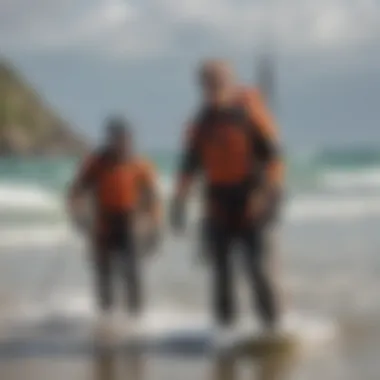
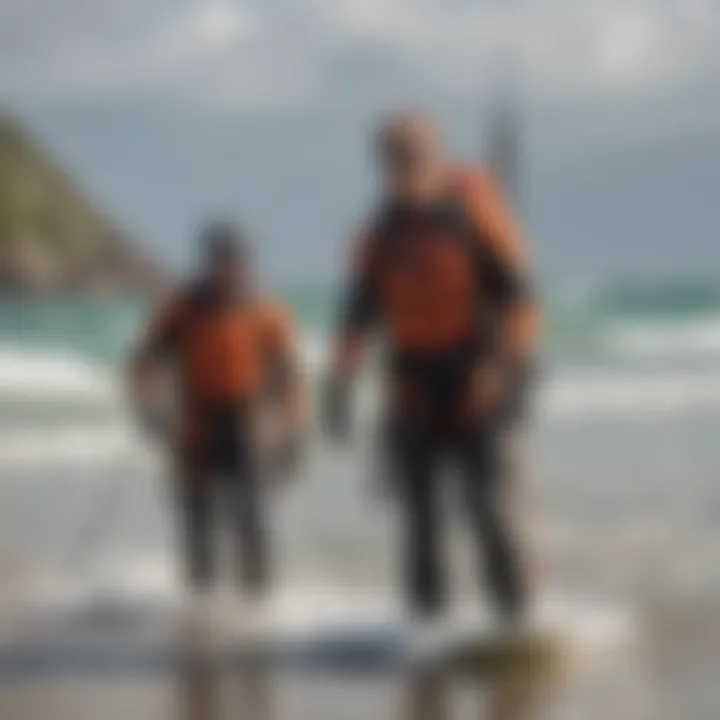
Community and Competitions
Community plays a crucial role in the world of kitesurfing. Whether you are just starting or already experienced, being part of a kitesurfing community enhances your experience. It provides support, knowledge sharing, and opportunities for growth. Competitions add another layer to this world by creating friendly rivalries and challenges that motivate individuals to push their limits.
Joining Kitesurfing Clubs
Kitesurfing clubs serve as a fundamental pillar for enthusiasts at all skill levels. These clubs often offer a structured framework for learning and can significantly accelerate one's progression in the sport. Newcomers benefit from the mentoring of seasoned kitesurfers who can provide valuable insights.
- Networking Opportunities: Being part of a club allows you to meet other kitesurfers. Sharing tips or stories helps build camaraderie.
- Access to Resources: Many clubs offer access to equipment, lessons, and even discounted rates for gear. This can be especially helpful for those who are not yet ready to invest heavily in equipment.
- Group Events: Clubs often organize events such as group kitesurfing sessions or social gatherings. These events foster community spirit and can make kitesurfing feel less intimidating for beginners.
Participating in Events
Engaging in kitesurfing events is not just about competition; it's also about experience. These events typically draw a diverse crowd, from novice kitesurfers to professionals. Participation can lead to many benefits.
- Skill Development: Competing pushes you to refine your techniques and understand your limits. You learn by watching others and may even receive feedback from judges or peers.
- Recognition and Rewards: Many events provide accolades or prizes for notable performances. Recognition can be motivating and affirm your dedication to the sport.
- Showcasing Talent: Events provide a platform to showcase skills, making it easier to attract sponsorships or media attention.
"Participating in competitions not only tests your abilities but also enriches your experience in the kitesurfing community."
In summary, both community and competitions within kitesurfing offer pathways for learning and connection. They ensure that regardless of experience, participants find ways to grow and enjoy the sport.
Environmental Considerations
The topic of environmental considerations is crucial in the context of leash kitesurfing. As this sport gains popularity, understanding its impact on ecosystems becomes essential. Kitesurfers must be aware of how their activities can affect marine environments, and vice versa. Environmental awareness leads to responsible practices that not only benefit the kitesurfers but also help preserve natural habitats.
Impact of Kitesurfing on Marine Life
Kitesurfing can have various impacts on marine life, some of which may not be immediately apparent. The presence of kitesurfers in sensitive areas can disrupt local wildlife. For example, feeding and nesting behaviors of birds along the shore can be affected if kitesurfers frequent these zones.
Furthermore, the physical presence of kites, boards, and human activity can disturb underwater ecosystems. Coral reefs and seagrass beds are particularly vulnerable. Kitesurfers should be conscious of these areas and avoid them whenever possible. Additionally, they should follow local regulations that protect these vital habitats.
"Awareness and care can mitigate the ecological footprint of kitesurfing and promote sustainability."
To minimize negative impacts on marine life, kitesurfers are encouraged to:
- Respect no-kite zones that are often designated to protect wildlife.
- Practice low-impact entry and exit points to minimize disturbance.
- Educate themselves on local marine ecology and species.
Sustainable Practices in Kitesurfing
Sustainable practices are an answer to the environmental concerns surrounding kitesurfing. As the sport develops, so do methods to engage in it responsibly. Integrating sustainability into kitesurfing encompasses various dimensions. From equipment selection to community involvement, every small change can have a cumulative positive effect.
Here are some sustainable practices that kitesurfers can adopt:
- Choosing Eco-Friendly Equipment: Brands are increasingly manufacturing kites and boards with sustainable materials. Look for products that focus on reduced environmental impact.
- Participating in Cleanup Events: Many kitesurfing communities organize beach cleanups. Getting involved helps remove debris that can harm marine life.
- Educating Others: Share knowledge about the importance of sustainability in kitesurfing. Encourage fellow enthusiasts to adopt eco-friendly practices.
- Advocating for Sustainable Policies: Support local policies that aim to protect coastal areas and promote sustainable tourism.
By integrating these sustainable practices, kite surfers can help ensure that their sport does not compromise the health of marine ecosystems. Through mindful engagement, the community can enhance their experience while protecting the environment.
Future Innovations in Kitesurfing
Kitesurfing, as an evolving sport, relies heavily on continued innovations. These advancements shape the way enthusiasts interact with their environment, enhance performance, and prioritize safety. It is crucial to acknowledge how technology and material science directly influence kitesurfing's trajectory. Future innovations not only aim to improve efficiency but also focus on addressing environmental issues and user experience. This section will delve into the specifics of technological advancements and the evolution of materials.
Technological Advancements
Technological advancements in kitesurfing include the ongoing development of smart kites and boards. These advancements typically involve integration with sensors and artificial intelligence. For instance, smart kites could adjust their shape or angle automatically in response to changing wind conditions. This could immensely improve stability and control for the rider, resulting in a safer and more enjoyable experience.
Other innovations include enhancements in safety equipment such as inflatable impact vests that provide buoyancy and impact protection. Some brands offer kites with built-in GPS tracking, allowing riders to monitor their location in real-time. This feature is particularly useful for those venturing into uncharted waters or isolated areas. It helps in ensuring safety while kitesurfing, allowing for timely rescue assistance if necessary.
Moreover, advancements in communication technology enable riders to stay connected with their support teams or fellow kitesurfers. Apps specifically designed for kitesurfing now allow users to share real-time conditions, including wind speed, water temperature, and overall environment assessments. This collective sharing of information can enhance safety and performance for all riders involved.
Material Evolution
The evolution of materials used in kitesurfing gear significantly impacts both performance and sustainability. Manufacturers are experimenting with lighter, more durable materials that maintain optimal kite performance without compromising strength. For example, advances in ripstop nylon and mylar can lead to kites that are both lightweight and resilient against wear and tear.
Additionally, the push for environmentally friendly materials has gained traction. The development of biodegradable materials for kites and boards is a win-win for both the sport and the planet. As kitesurfers become more conscientious about their impact on marine ecosystems, the demand for sustainable gear is likely to grow.







